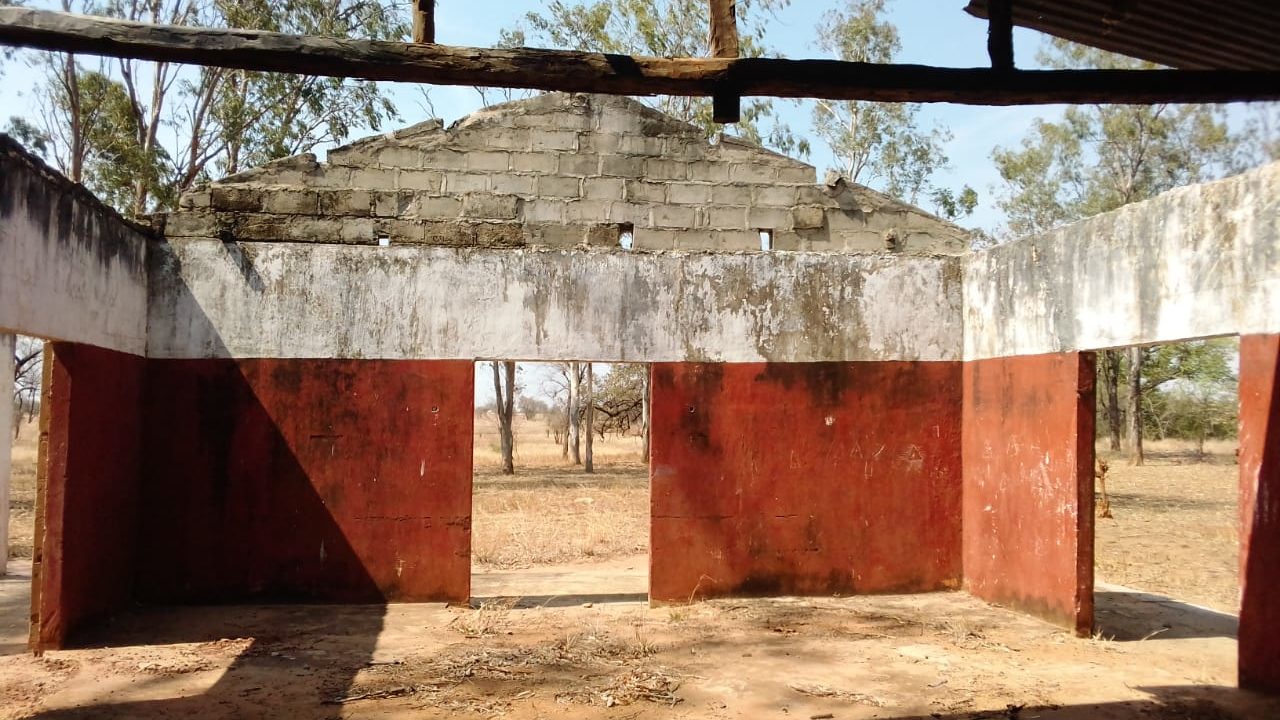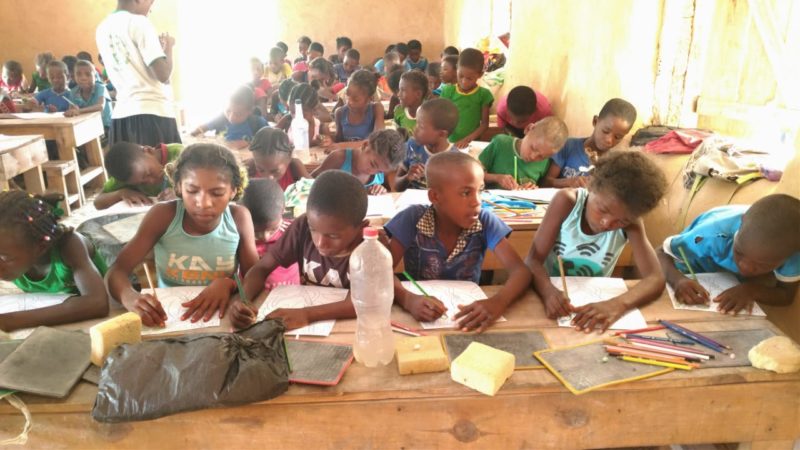IT WAS A YEAR AGO – One year already we completed the construction of a new school and the renovation of 3 others in the villages of Makay. The year 2020 was strewn with pitfalls and the emergencies related to Covid prevented us from telling you earlier about these beautiful advances for the schooling of children in Makay. So, join us for a short detour through the bush schools of Madagascar and the very warm construction sites.

The school on the Makay River: another ecosystem at risk
Landlocked and impoverished, the villages on the outskirts of the massif are totally deprived of education. The buildings are dilapidated or non-existent. Poorly paid and forced to work their rice fields in order to support themselves, many teachers quit their jobs.
In this context of educational bankruptcy, parents are very distrustful and they prefer to mobilize their children in the fields rather than send them to school. Illiteracy is reaching peaks, permanently altering the prospects of getting out of precariousness. It should be noted that schooling of children is still the primary concern of local authorities.

Case of school in Tsiazorambo
Crammed into a tiny hut, with no window, table or chair, about 15 children between the ages of 3 and 12 squatted on mats in the dust and darkness. Despite precarious conditions, these few children, whose parents can finance their education, continue to come to “school”. The masure – which threatens to collapse on the pupils and their teacher – is nothing like a school, apart from the usefulness that its courageous occupants still give it.
During our last visit to Tsiazorambo, a small locality in North Makay, the komity (the “chiefs” of the 5 hamlets that make up the village of Tsiazorambo) had expressed the wish that Naturevolution would finance the construction of a new school. The request was of an urgent and priority nature.
We decided to mobilize and take advantage of the summer eco-volunteer missions to start the project.
First, there are discussions to present the construction techniques and plans of the building, the choice of location, the construction of the foundations, the enthusiastic workforce, the incessant back and forth to the river to fill the buckets of water needed to mix sand and cement. Then it is necessary to find the logs for the frame and the frames of doors and windows.

The walls are rising, but the work is in danger of being interrupted twice. First, the delivery of the cement bags is delayed, and the villagers who are worried and impatient need to be reassured. We negotiate with the cement company and end up picking up the bags ourselves in Morondava (2 days round trip).
Then comes the turn of the villagers who, over the course of the days, are no longer as numerous on the site as at the beginning. Under the palm tree, once again, we sit down to explain that it will take the increased and sustained presence of several dozen villagers to meet the deadlines.
Soon, construction resumed with renewed energy, no one lost sight of the objective: it is a question of equipping Tsiazorambo with a school for the start of the academic year in October and thus allowing more children to attend school. Moreover, the latter turn daily around the construction site, their desire to get their hands on the dough is sometimes hard to curb !

In mid-August, the building has 4 coated walls, a concrete slab and all the furniture designed during the previous eco-volunteer mission. The carpenter then manufactures the doors and shutters, and assembles the frame. In September, the delivery of the sheets allows the roofing of the building and the wood processing of the furniture.
Two field missions, the participation of the villagers and about twenty eco-volunteers who joined us on our local development assistance missions, combined with the expertise of a carpenter, were necessary for the 50 m2 building to emerge from the ground.
The inauguration will take place on 24 September 2019 In front of the cameras of TV Madagascar in the presence of a number of representatives of the regional authorities, among them: the deputy mayor of Malaimbandy, the ZAP chief (responsible for education of the district of Malaimbandy), the cantonment chief of Mahabo (authority of the Ministry of Forests), some gendarmes of the district, as well as the 5 komity of Tsiazorambo (the heads of hamlets). The occasion brings the whole village together and the festivities continue into the night !

Completed just in time for the 2019-2020 school year, the Tsiazorambo school now has 279 students compared to about 15 the previous year..
In addition to the building, Naturevolution furnishes and provides the school supplies for all the students and undertakes to cover the salary of the 2 teachers. The latter share school time so that all the children attending school take turns in the single class.


And also three renovation projects
In Sakoazato, another locality in North Makay, the building, open to the four winds, is empty of any furniture, the latter having been used as firewood. In the autumn of 2019, as part of an eco-voluntary project, we are equipping it with doors and windows and manufacturing brand new furniture. A year later, a few days of work are dedicated to the exterior coating and treatment of the wood in order to protect it from termites.

In the south, existing schools require some work – construction of verandas, various repairs (carpets, roofs, coatings, etc.), furniture and shutters.
In Beronono, all of this work will be carried out in October 2019 with the help of a new team of eco-volunteers. The small building is operational only a few weeks after the start of the school year and since then welcomes about sixty children.
In Tsivoko, the building is also in poor condition, due to lack of maintenance (especially the casings) and we add a veranda to protect its walls before the repair of the plaster and casings scheduled for 2020 (finally postponed due to the health crisis).
To enable all students to work, each of these schools is provided with notebooks, a blackboard, slates, chalk and sponges, kits, rules and protractors, coloured pencil and pens, textbooks, etc.
In 2019, we provided assistance to 4 villages in the south and north of the Makay massif, through:
- the construction of a new school and the renovation of three others,
- equipping 2 schools with school furniture,
- distribution of supplies for more than 350 children,
- Paying for the salaries of 5 teachers.

Teachers trained and paid for quality mentoring
It goes without saying that without a teacher all this equipment would be in vain. But it is not easy to find a well-trained and voluntary teacher who is serious and concerned with ensuring continuity in the teaching process. It should be borne in mind that few National Education graduates agree to come and teach in remote areas such as Makay.
Volunteers on posts are poorly trained, abandoned from their hierarchy, and in many cases their remuneration is not provided by the State, but by the families of the pupils. They pay school fees in kind by providing portions of rice, and when their meagre incomes and harvests are insufficient, they withdraw their children from school. The teacher is left with a low staff – as are his resources – and has no choice but to go to work in the rice fields to ensure his survival.
In order to compensate for vacancies, we are in discussions with the competent authorities to obtain as many qualified teachers as possible. When this demand cannot be met, we finance the training and salaries of new teachers (5 teachers now benefit).

The objectives of the project “Le Makay à bonne école”
While we are very pleased with these achievements, we are also well aware that they are only the first step in supporting all the communities of Makay so that access to education is no longer the prerogative of a privileged few.
In Tsiazorambo, for example, it will soon be necessary to add a second classroom to the new building, as today’s capacity is far exceeded. Some villages in Makay do not even have a school or it is almost unusable, as was the case in Tsiazorambo. The prerequisite for schooling is then the construction of a building.
Thus, in order to guarantee quality education and a decent learning environment for all, we plan to build, renovate and equip 5 schools per year, while paying for the training and salaries of several teachers recruited.
To learn more about and support the Education component of the Makay Project,
Rendezvous on “Les enfants du Makay à bonne école !”

